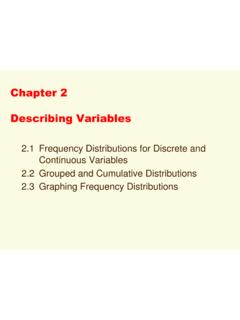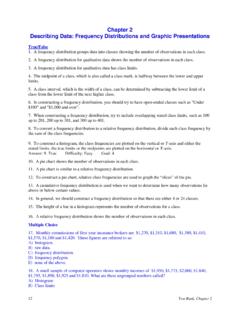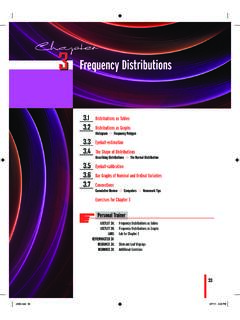Transcription of Chapter 2: Frequency Distributions and Graphs
1 Chapter 2: Frequency Distributions and GraphsDiana PellSection : Organizing DataAfrequency distributionis the organization of raw data in table form, using classes Frequency DistributionsExercise army inductees were given a blood test to determine their blood data set isConstruct a Frequency distribution for the distributionis the organization of raw data in table form, using classes Frequency DistributionsExercise a researcher wished to do a study on the ages of the 50 wealthiest peoplein the class limits:upper class limits:Note:The class limits should have the same decimal place value as the data, but the classboundaries should have one additional place value and end in a widthfor a class in a Frequency distribution is found by subtracting the lower (orupper) class limit of one class from the lower (or upper) class limit of the next :Do not subtract the limits of a single class.
2 It will result in an incorrect Frequency distribution should abide the following rules:1. There should be between 5 and 20 It is preferable but not absolutely necessary that the class width be an odd number. Theclass midpointXmis obtained by adding the lower and upper boundaries and dividing by2, or adding the lower and upper limits and dividing by 23. The classes must be mutually The classes must be continuous (no gaps).5. The classes must be exhaustive. There should be enough classes to accommodate all the The classes must be equal in a Grouped Frequency Distribution1. Determine the Find the highest and lowest Find the Select the number of classes Find the width by dividing the range by the number of classes and rounding Select a starting point (usually the lowest value or any convenient number less than the lowestvalue); add the width to get the lower Find the upper class Find the Tally the Find the numerical frequencies from the tallies, and find the cumulative data represent the record high temperatures in degrees Fahrenheit ( F) foreach of the 50 states.
3 Construct a grouped Frequency distribution for the data, using 7 an Ungrouped Frequency DistributionExercise data shown here represent the number of miles per gallon (mpg) that 30 se-lected four-wheel-drive sport utility vehicles obtained in city driving. Construct a frequencydistribution, and analyze the frequenciesare:5 Exercise data represent the ages of our Presidents at the time they were first Were the data obtained from a population or a sample? Explain your What was the age of the oldest President?c. What was the age of the youngest President?d. Construct a Frequency distribution for the data using 7 Are there any peaks in the distribution ?f. Identify any possible Write a brief summary of the nature of the data as shown in the Frequency : Histograms, Frequency Polygons, and OgivesThe three most commonly used Graphs in research are1.
4 The The Frequency The cumulative Frequency graph , or a graph that displays the data by using contiguous vertical bars (unless thefrequency of a class is 0) of various heights to represent the frequencies of the a histogram to represent the data shown for the record high tempera-tures for each of the 50 polygonis a graph that displays the data by using lines that connect pointsplotted for the frequencies at the midpoints of the classes. The frequencies are represented bythe heights of the the Frequency distribution given in Exercise 6, construct a Frequency a graph that represents the cumulative frequencies for the classes in a an ogive for the Frequency distribution described in Exercise 4 Shapes8 Exercise you are a realtor in Bradenton, Florida.
5 You have recently obtained alisting of the selling prices of the homes that have sold in that area in the last 6 months. Youwish to organize those data so you will be able to provide potential buyers with useful informa-tion. Use the following data to create a histogram, Frequency polygon, and cumulative What questions could be answered more easily by looking at the histogram rather than thelisting of home prices?b. What different questions could be answered more easily by looking at the Frequency polygonrather than the listing of home prices?c. What different questions could be answered more easily by looking at the cumulative frequencypolygon rather than the listing of home prices?
6 D. Are there any extremely large or extremely small data values compared to the other datavalues?e. Which graph displays these extremes the best?f. Is the distribution skewed?9 Section : Other Types of GraphsAbar graphrepresents the data by using vertical or horizontal bars whose heights or lengthsrepresent the frequencies of the table shows the average money spent by first-year college students. Draw ahorizontal and vertical bar graph for the Graphs can also be used to compare data for two or more groups. These types of bar graphsare calledcompound bar Graphs . Consider the following data for the number (in millions) ofnever married adults in the United :Read about a Pareto chart and time series graph !
7 !!Apie graphis a circle that is divided into sections or wedges according to the percentage offrequencies in each category of the Frequency distribution shows the number of pounds of each snack food eatenduring the Super Bowl. Construct a pie graph for the a statistical graph in which each data value is plotted as a point (dot) above thehorizontal data show the number of named storms each year for the last 40 and analyze a dotplot for the and leaf plotis a data plot that uses part of the data value as the stem and part ofthe data value as the leaf to form groups or an outpatient testing center, the number of cardiograms performed each dayfor 20 days is shown. Construct a stem and leaf plot for the Graphs13

















